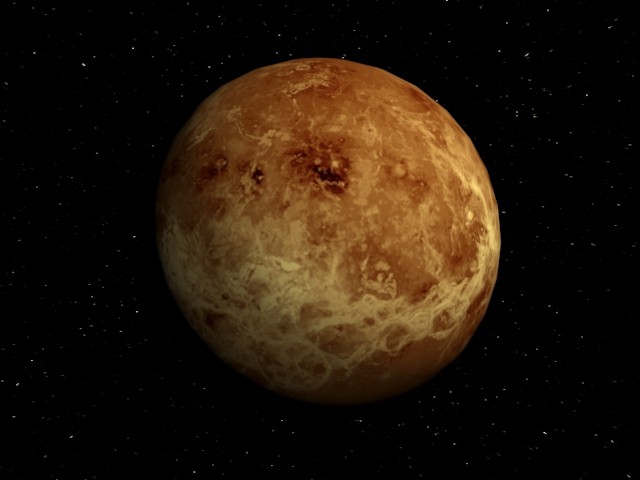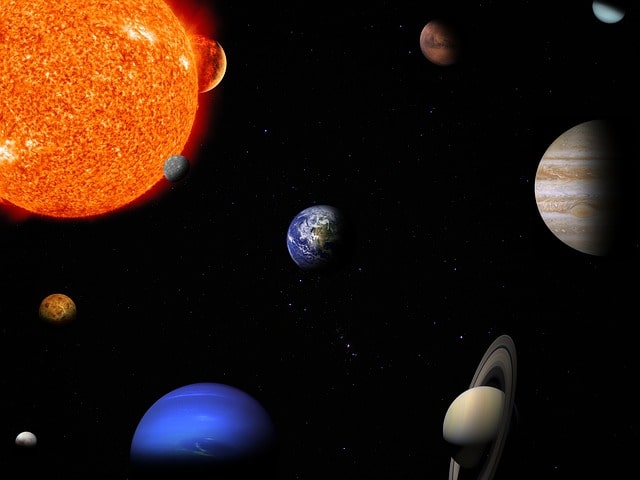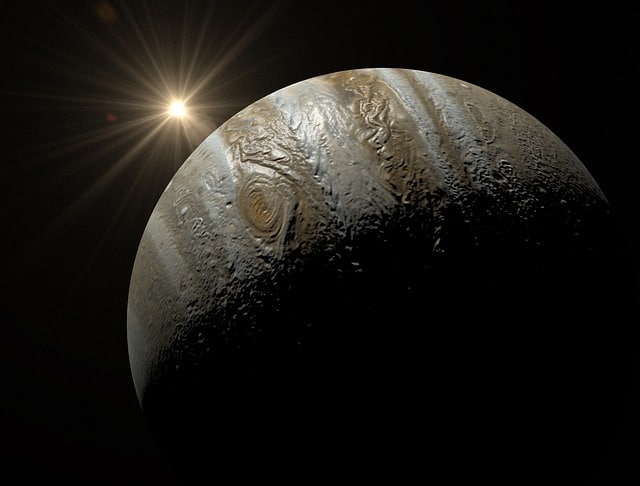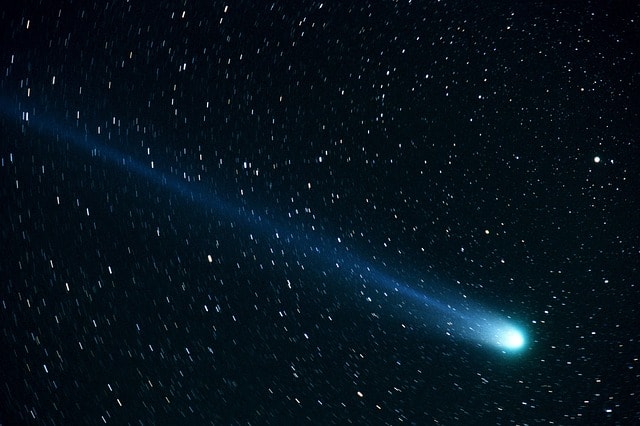What is the Kuiper Belt?
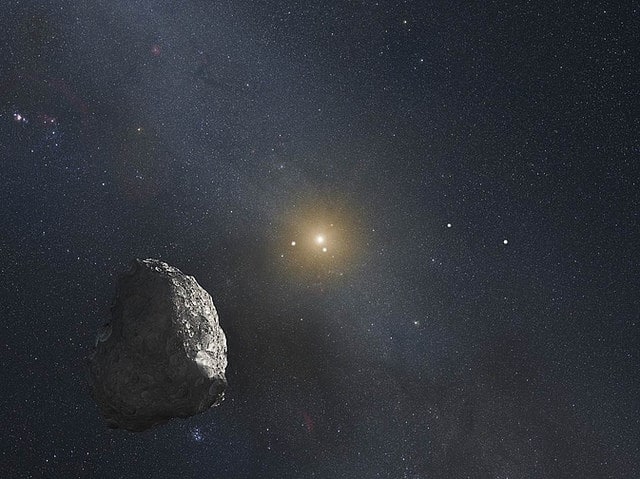
The Kuiper Belt, or the Edgeworth-Kuiper belt is a disc (circumstellar) found at the outer most regions of our solar system. This extends from Neptune’s orbit at approximately thirty (30) AU to about fifty (50) AU from our sun. The Kuiper belt is somewhat similar to the asteroid belt in terms of composition but as for size, it is much larger, about twenty (20) times as wide and one-hundred and fifty (150) times as large.
Similar to the asteroid belt between the Terrestrial and Jovian planets, the Kuiper Belt consists of mainly remnants (or small bodies) from the pre-developed Solar System while many of the asteroids here are mainly composed of metal and rock, the belt also consists of objects largely composed of frozen volatiles such as water, ammonia and methane.
According to NASA,
“The Kuiper Belt is a disc-shaped region beyond Neptune that extends from about 30 to 55 astronomical units (compared to Earth which is one astronomical unit, or AU, from the sun). This distant region is probably populated with hundreds of thousands of icy bodies larger than 100 km (62 miles) across and an estimated trillion or more comets.”
It is home to three (3) recognized dwarf planets, Makemake, Haumea and the beloved Pluto. It has been hypothesized that some of the moons that now belong to the Gas Giants such as Saturn’s Phoebe and Neptune’s Triton have originated from the Kuiper Belt.
It was Gerard Kuiper, a Dutch-American astronomer, who discovered the Kuiper Belt. Originally, he did not predict its existence until 1992 when he discovered a KBO or Kuiper belt object, the former planet named Pluto. Since the discovery of Pluto, there have been more asteroid discoveries with the same composition as Pluto. About 100,000 more KBOs spanning over a hundred (100) kilometers have been discovered.
Location of the Kuiper Belt
The belt was originally thought to be a repository for comets with orbits spanning no more than two-hundred (200) years. However, recent studies have shown that the Kuiper Belt is stable and the place of origin of most comets is the scattered disc. The scattered disc is an active zone that was created by the outward movement of Neptune about four and a half (4.5) billion years ago. Scarred disc masses such as the asteroid Eris have very eccentric orbits that can take them up to a hundred (100) AU from the Sun.
The main body of the Kuiper belt extends from a mean-motion resonance of 2:3 at approximately forty (40) AU to a resonance of 1:2 at forty-eight (48) AU. This makes the Kuiper belt thick with the main concentration of masses extending to about ten (10) degrees from the ecliptic plane.
The presence of the Gas Giant Neptune has a very significant effect on the belt’s structure due to its orbital resonances. This is because Neptune’s gravity destabilizes the orbit of objects that lie at certain regions. It either sends them flying to the inner portions of our Solar system or out to the vast regions of interstellar space. In fact, because of the gravitational effects of Neptune, at forty-one (41) AU, no objects retain stable orbits for long periods of time.
The asteroids in the Kuiper Belt is divided into two. The first is called the dynamically cold population which have orbits with an eccentricity of 0.1 or less and with low inclinations ranging from five (5) to ten (10) degrees. This population also contains most of the asteroids which is sometimes called the kernel with axes at forty-four (44) AU. The second is the dynamically hot population. Their orbits are more inclined to the ecliptic by up to thirty (30) degrees. Both of these populations have been named in this manner not because of their temperature, but because of their analogy with the particles found in gas.
The particles found in gaseous elements have increased velocities when they are subjected to heat. Another significant difference between the dynamically cold and dynamically hot population is their respective albedo and color. The dynamically cold population has a lighter and redder albedo and color, respectively. This population also contains smaller masses compared to the dynamically hot population.
At a resonance of 1:2 is where very few objects are known. Though it isn’t clear whether this is actually the outer edge of the belt or is simply the beginning of something else. Several objects have been discovered at a resonance of 2:5, roughly fifty-five (55) AU, which is outside the belt.
Though the Kuiper belt has been rigorously studied it is still unclear of where its precise origin is. In addition, its very intricate structure still remains a mystery. Astronomers are still waiting for the completion of multiple field survey telescopes such as the LSST and Pan-STARRS that could possibly reveal the locations of many unknown Kuiper Belt Objects or KBOs.
Moreover, scientists also speculate that the Kuiper Belt contains an abundant amount of planetesimals. Planetesimals are fragments from the first protoplanetary disc from the Sun that was initially thought to have failed to completely coalesce into the planets and have thus, developed into smaller bodies.
Due to the scarcity of small craters found in planetesimals such as Charon and Pluto, it was hypothesized that these masses have formed as a direct result of accretion from larger planets or bodies. The formation of these hypothetical mechanisms include the gravitational collapse of cloud pebbles concentrated in a turbulent disc or in other types of instabilities.
Due to its distance from the Sun and other planets in our solar system, the KBOs are thought to be somewhat unaffected by the processes that formed other objects of the Solar System and thus, the determination of their respective compositions will provide a great deal of information regarding the makeup of the early status of our Solar System.
Astronomers determine the composition of an object in space by spectroscopy wherein the light given off by any object in space is separated into color components resulting in a “rainbow-like” image. This “rainbow-like” image is called a spectrum and is possible because different substances react to light at a variety of wavelengths and thus, a different image is produced when light hits an object of different or varying composition.
All elements in the periodic table of elements absorb light in a different way and give off certain colors, using this, scientists can deduce an object’s fingerprint and therefore, determine its relative composition.
The area or portion of the Kuiper belt where objects extending beyond the hundred (100) AU mark is referred as the scattered disc, which is a sparsely populated region. They bear very elliptical orbits are inclined with respect to the ecliptic. It is believed that these objects have formed simultaneously with the other parts of the Kuiper belt, but due to the interaction of gravitational forces, have separated and moved into this region.

